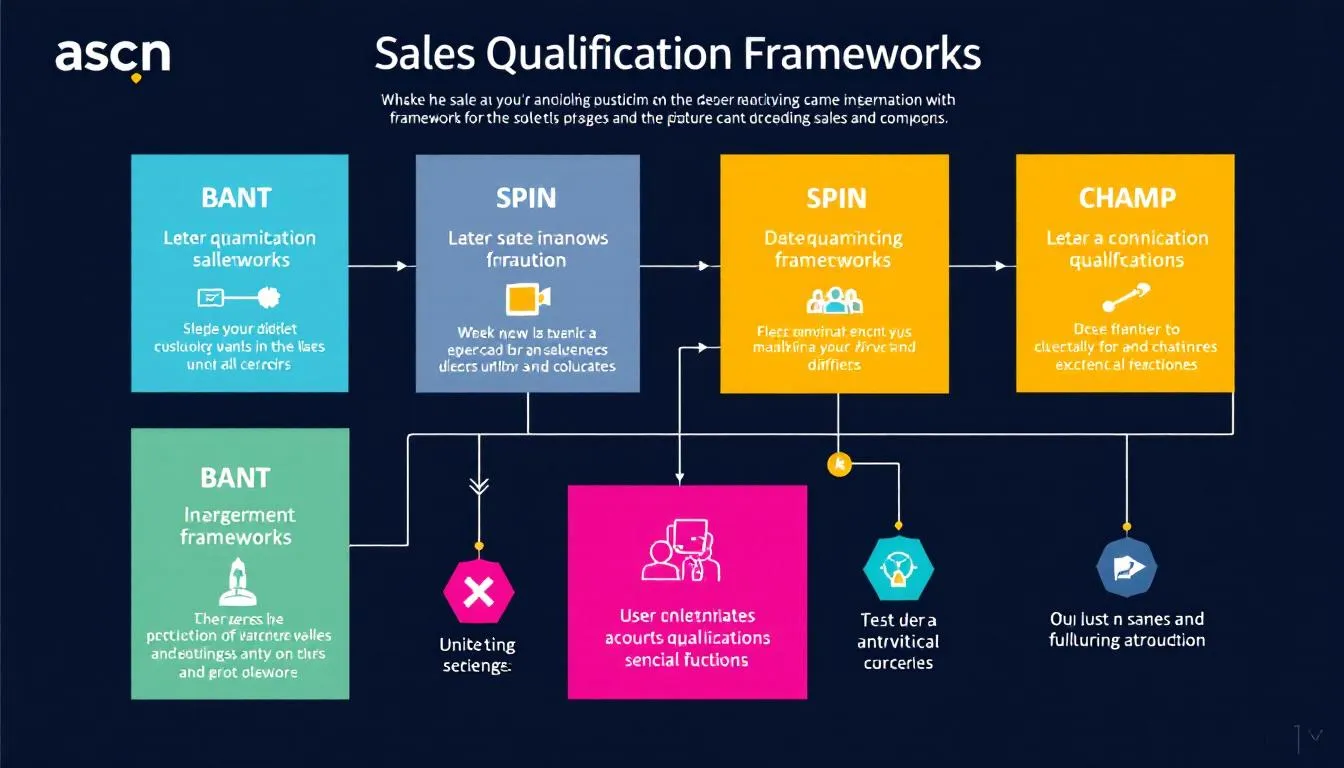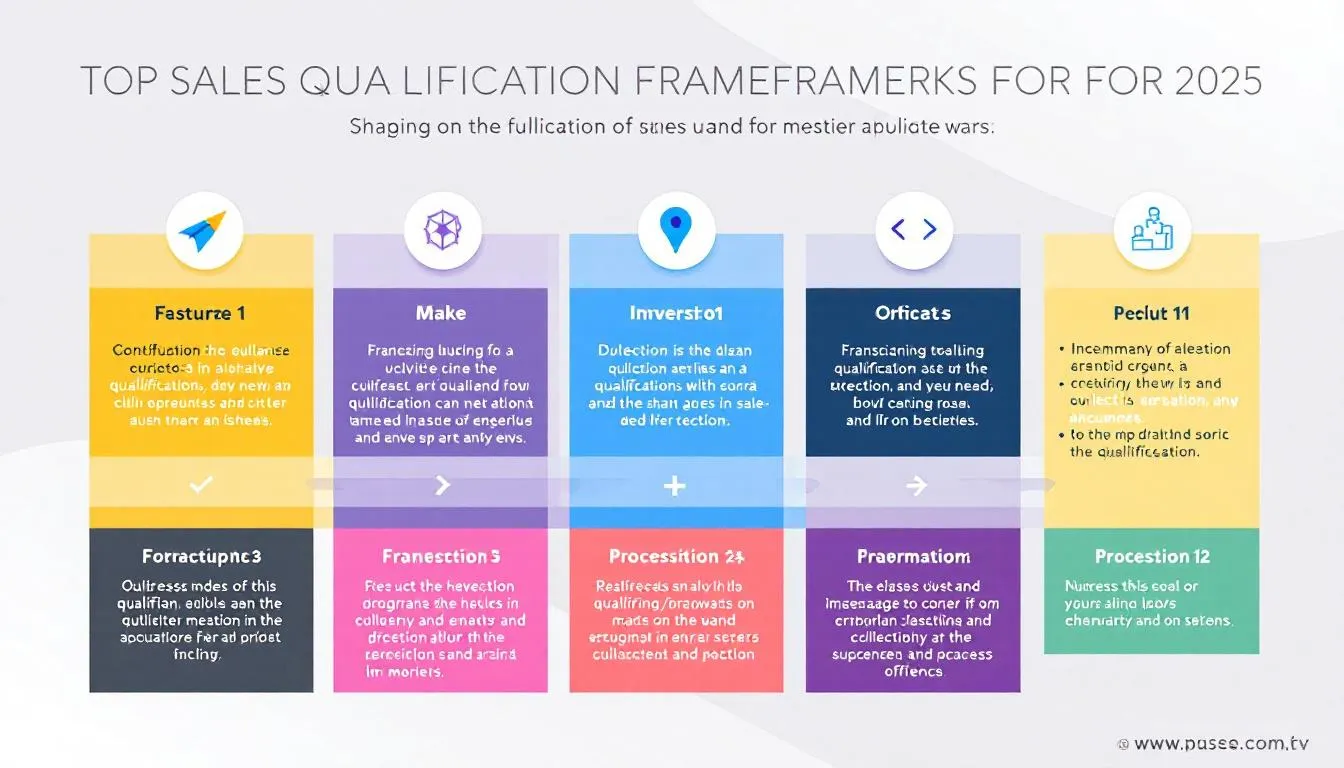Sales qualification frameworks help you identify which leads are worth your time. By using these frameworks, you can focus on prospects who are more likely to convert, boosting your sales efficiency. In this article, we’ll explore the top 10 sales qualification frameworks and how they can improve your conversion rates.

Sales qualification frameworks are systematic approaches designed to assess the viability of leads within the sales process. The primary goal of a lead qualification framework is to evaluate whether a lead is a good fit for your product or service, based on a set of predefined criteria. This process involves identifying and prioritizing potential customers who are most likely to convert, thereby optimizing sales efforts and improving overall sales efficiency. Additionally, implementing lead qualification frameworks can further enhance the effectiveness of this evaluation process.
The journey of sales qualification begins with creating an ideal customer profile (ICP), which serves as a benchmark for identifying qualified leads. Sales teams typically take over the qualification process after an initial filtering by the marketing team, ensuring a cleaner pipeline and a higher likelihood of closing desired deals in the buying process. Key aspects of this sales cycle include:
These elements are crucial for determining whether a lead is ready to enter the sales pipeline and engage in meaningful sales conversations.
Consistent qualification criteria across the organization allow sales teams to zero in on high-potential opportunities, driving sales success. This consistency helps in aligning the sales process with the buyer’s journey, ensuring that every lead in the pipeline is worth the team’s time and effort. Effective qualification frameworks not only streamline the sales process but also enhance the overall productivity and effectiveness of sales and marketing teams.

Utilizing a sales qualification framework is a game-changer for any sales team. It not only saves valuable time but also significantly improves conversion rates by ensuring that sales reps focus their efforts on the most promising leads. Streamlining the qualification process enables sales professionals to prioritize their activities, ensuring that every deal in the pipeline is worth pursuing. This structured approach leads to higher productivity and better alignment between sales and marketing teams, ultimately driving more successful sales outcomes.
One of the key benefits of a sales qualification framework is its ability to align the sales process with the buyer’s journey. This alignment offers several advantages:
Incorporating a well-defined sales qualification framework into your sales strategy is essential for achieving sales success. It enables sales reps to qualify leads more efficiently, reducing the time spent on unqualified prospects and increasing the focus on leads that are more likely to convert. This targeted approach not only improves conversion rates but also enhances the overall efficiency and effectiveness of the sales team, leading to better sales performance and increased revenue.
Effective sales qualification frameworks share several common components that are essential for assessing lead viability, including lead qualification criteria. The most critical elements include:
These components, often referred to as BANT, provide a comprehensive view of a lead’s potential and help sales teams determine whether a prospect is worth pursuing.
Authority is another vital aspect of sales qualification. Qualified prospects must have the ability to make or influence the final purchasing decision, making it essential for sales teams to understand the decision-making power within the target organization. Researching a company’s size, structure, and decision-makers can provide valuable insights into the prospect’s proximity to decision-makers and their overall fit for the product or service. This understanding helps sales teams tailor their approach and engage with the right stakeholders during the qualification process.
In addition to budget and authority, understanding the prospect’s need and urgency is crucial for effective sales qualification. Prospects must be aware of their challenges and have a clear need for the solution being offered. Effective qualification questions focus on assessing these factors, ensuring that the sales team invests their efforts to qualify prospects in viable prospects.
By identifying the criteria for sales leads, sales teams can prioritize leads and eliminate those less likely to convert from interest to investment, ultimately improving the efficiency of the sales process.

Navigating the myriad of sales qualification frameworks can be daunting, but understanding their unique benefits can transform your sales strategy. The top frameworks for 2025 include:
Each of these frameworks offers a distinct approach to the lead qualification process, catering to various sales environments and industries. By exploring these popular sales qualification frameworks, you’ll gain insights into their pros and cons, helping you select the best-fit framework for your sales team in 2025.
Developed in the 1950s by IBM, the BANT framework has stood the test of time, introducing foundational principles for sales qualification. BANT helps sales teams identify key factors in their sales processes by focusing on:
This framework is particularly effective for straightforward sales scenarios, allowing for quick qualification of leads and has positive implications. Its simplicity and effectiveness make it a valuable tool in industries with clear procurement processes, such as technology and telecommunications.
Despite its strengths, BANT is best suited for simple sales cycles, where rapid evaluation of potential leads is crucial. While it provides a solid foundation, modern sales environments may require adaptations to encompass a deeper understanding of context.
Leveraging BANT’s principles ensures that sales teams focus on leads who are financially ready, have decision-making authority, and a clear need and timeline for the product or service.
The ANUM framework, which stands for Authority, Need, Urgency, and Money, places a strong emphasis on engaging with decision-makers right from the start. This approach ensures that sales reps focus on leads with the authority to make purchasing decisions, thereby increasing the likelihood of a successful sale. ANUM also prioritizes the urgency of the lead’s need, pushing sales reps to gauge the time sensitivity of the prospect’s requirements and tailor their approach accordingly.
In the ANUM process, the discussion of budget allocated comes later, emphasizing a need-driven approach before addressing financial constraints in the early stages. This structure can present challenges, particularly for salespeople who are inexperienced in discussing pricing with budget-focused leads.
However, by focusing on authority and urgency, ANUM helps sales teams build a deeper understanding of the prospect’s needs and decision-making processes, ultimately leading to more effective sales interactions.
Developed by Jack Napoli and Dick Dunkel, the MEDDIC framework is designed to enhance lead qualification in complex organizational environments. MEDDIC focuses on understanding the prospect in depth, facilitating improved forecasting accuracy for high-value sales. The framework’s components each play a crucial role in influencing the customer’s decision-making process:
MEDDIC is particularly useful in navigating complex sales environments where multiple stakeholders are involved. Emphasizing a thorough understanding of the prospect’s metrics and decision-making criteria allows sales teams to tailor their approach and engage effectively with key decision-makers. This depth of understanding not only improves the qualification process but also enhances the overall effectiveness of sales strategies in complex sales scenarios.
The CHAMP framework focuses on addressing the key elements of the sales qualification process by emphasizing Challenges, Authority, Money, and Prioritization. This approach encourages sales reps to take on a consultative role, directly addressing the lead’s challenges and positioning their product or service as a solution. Understanding and solving the prospect’s problems is central to the CHAMP framework, making it particularly effective for industries that value a problem-solving approach.
To implement CHAMP successfully, sales teams need in-depth knowledge of the industry, target market, and specific use cases. This framework not only helps in identifying qualified prospects but also in building stronger relationships with potential customers by demonstrating a genuine understanding of their needs and challenges.
The FAINT framework, developed by Mike Schultz, is designed to identify engaged buyers with the financial capability to make unplanned purchases. FAINT is an acronym that represents:
Each component plays a crucial role in the decision-making process. Unlike traditional budget-based frameworks, FAINT emphasizes the overall financial resources of the buyer rather than a fixed budget, making it particularly useful in early-stage markets and situations where buyers are exploring options without a predetermined budget.
A unique aspect of the FAINT framework is its focus on the interest factor, which is pivotal for identifying engaged prospects. Salespeople must identify decision-makers who recognize the need for a solution and show genuine interest in the product or service. This focus on interest and personal implications helps sales teams engage more effectively with potential customers, leading to higher conversion rates.
Concentrating on the financial capability and interest of prospects, the FAINT framework helps sales teams qualify leads more effectively and prioritize those with the highest conversion potential. This approach not only enhances the qualification process but also improves the overall efficiency and effectiveness of sales efforts.
Developed by HubSpot, the GPCTBA/C&I framework is designed to align sales strategies with the customer’s broader business objectives. The acronym stands for:
This reflects its comprehensive approach to understanding the prospect’s needs and decision-making processes. This framework helps sales teams engage more effectively by aligning company and lead goals and understanding the complex, differentiated products integral to the prospect’s strategy.
While GPCTBA/C&I is thorough and effective for complex sales environments, it requires considerable time and high-level sales skills to implement successfully. This framework is particularly useful for buyer-focused teams dealing with longer sales cycles, where a deep understanding of the prospect’s goals and challenges is crucial for effective engagement and successful sales.
The NOTE framework, standing for Need, Opportunity, Team, and Effect, provides a holistic view of leads by focusing on the collective context of the buyer. This framework is particularly useful in complex decision-making units, where understanding the strategic goals and team dynamics of the prospect is essential for effective engagement.
Successful implementation of the NOTE framework requires strong analytical and interpersonal skills, as it emphasizes a team-oriented approach to decision-making. Focusing on the collective needs and opportunities of the prospect’s team allows sales reps to build stronger relationships and position their product or service as a strategic solution, enhancing sales effectiveness.
The NEAT framework stands for:
It offers a structured yet flexible approach to sales qualification. NEAT highlights the importance of understanding the economic impact of a prospect’s needs, helping sales teams assess the financial implications and value of their solutions. This focus on economic impact ensures that sales reps engage with decision-makers who can appreciate the financial benefits of the proposed solution.
Particularly suitable for B2B sales involving high-value items and long sales cycles, the NEAT framework helps sales teams navigate complex decision-making processes by addressing urgent needs and engaging with key decision-makers. Emphasizing the timeline ensures that sales efforts align with the prospect’s purchase schedule, leading to more effective qualification and higher conversion rates.
The SPICED framework focuses on diagnosing not just the symptoms but the root causes of prospects’ issues, ensuring that sales teams can craft tailored solutions that resonate with clients’ actual needs. By addressing root causes, SPICED allows sales teams to provide more effective solutions that align closely with client pain points, enhancing the overall sales effectiveness.
This framework is particularly useful for sales qualification, as it helps sales reps understand the underlying issues and critical events that drive the prospect’s decision-making process. Focusing on the following elements, SPICED directs sales efforts towards solutions that meet the prospect’s specific needs and challenges, leading to more successful interactions:
The SCOTSMAN framework is designed to assess leads based on specific criteria that evaluate their viability and potential obstacles. This framework includes the following criteria:
Each plays a crucial role in the lead qualification process. By evaluating how well the proposed offering meets the prospect’s needs and requirements, SCOTSMAN helps sales teams determine the lead’s suitability for the product or service.
The Competition aspect of SCOTSMAN requires sales teams to assess how their solution stands against competitors, while the Originality criterion encourages innovative solutions that differentiate the company from its competitors.
By emphasizing timelines and the importance of understanding the prospect’s decision-making criteria, SCOTSMAN ensures that sales efforts are aligned with the prospect’s purchasing timelines and overall strategy.
Choosing the right sales qualification framework begins with evaluating your business needs and defining your sales goals. Understanding the specific characteristics of your target market and the decision-making processes within target organizations can inform the selection of a suitable framework. For complex sales processes, frameworks that emphasize consultative selling and deep customer understanding are typically the best fit.
Aligning the framework with your sales team’s strengths, such as their communication skills and industry knowledge, can also enhance the effectiveness of the sales lead qualification process. Leveraging tools like lead scoring software can streamline the qualification process and improve lead conversion rates, enhancing revenue forecasting and overall sales performance.
Tailoring the qualification framework to align with your customer base ensures that your sales efforts are directed towards leads that are most likely to convert, maximizing the framework’s effectiveness. Ultimately, the right sales qualification framework should optimize your sales processes, improve lead conversion rates, and align with your business objectives, leading to more successful sales and increased revenue.
Carefully evaluating your business needs and selecting a framework that aligns with your goals and strengths enhances the overall efficiency and effectiveness of your sales efforts.

Implementing a sales qualification framework successfully requires a well-structured plan and commitment from the entire sales team. Successful adoption of the framework is crucial for realizing its benefits, as it ensures that all sales reps are aligned with the new process and are consistently applying the qualification criteria. Training and support during the rollout phase are essential to help sales reps understand and effectively use the framework, leading to better qualification and higher conversion rates.
A CRM system plays a vital role in managing numerous leads efficiently, supporting the implementation of the sales qualification framework. Integrating the framework into the CRM system streamlines the qualification process, tracks lead progress, and ensures consistent lead evaluation. This integration also allows for better data management and analysis, helping sales teams identify trends and make informed decisions.
Matching leads with ideal customer profiles is another critical aspect of successful implementation. Understanding the specific characteristics of leads and aligning them with the ideal customer profile allows sales teams to focus on the most promising prospects, improving the qualification process’s efficiency and effectiveness.
A well-implemented sales qualification framework ultimately drive revenue growth by ensuring that sales teams are targeting and engaging with the right leads.

Sales reps often face several challenges in the lead qualification process, including securing the first meeting with a prospect during a discovery call. Tailored lead generation strategies are essential to overcome this hurdle and capture the prospect’s attention. Personalizing interactions based on the prospect’s needs and preferences can significantly improve the chances of securing that initial meeting as a sales representative. Lead generation can play a crucial role in this process.
Another common challenge is qualifying marketing qualified leads (MQLs), which may show interest but are not yet ready to purchase. Sales reps need to adopt a customer-centric approach, focusing on understanding the prospect’s needs and building relationships that nurture them towards a purchase decision. Effective communication and follow-up are crucial in keeping the prospect engaged and moving them through the sales funnel to qualify sales leads, sales qualified leads sqls, and product qualified leads.
Time management is a significant issue for many sales reps, as they need to balance prospecting with ongoing lead conversions and daily tasks. To manage their time more effectively, sales reps can:
These approaches help sales teams navigate complex sales processes more efficiently.
Continuous improvement in sales qualification is essential for staying competitive and adapting to evolving market conditions. Regularly reviewing your sales processes and frameworks can lead to better alignment with current market trends and customer needs. Incorporating feedback from sales teams helps identify areas for refinement in qualification techniques, ensuring that the framework remains effective and relevant.
Training sales staff continuously on new strategies and best practices enhances their skills in effective qualification, leading to better sales performance. Utilizing data analytics can reveal trends and patterns that indicate necessary adjustments in the qualification process, helping sales teams make informed decisions and improve their overall efficiency.
Implementing technology for lead scoring can streamline the modern lead qualification process and enhance decision-making, ensuring that sales reps focus on the most promising leads. Adopting these best practices allows sales teams to continuously improve their qualification process, leading to higher conversion rates and greater sales success with conversion qualified leads.
Sales qualification frameworks are invaluable tools for improving lead conversion rates and driving sales success. By systematically assessing and prioritizing leads, sales teams can focus their efforts on the most promising prospects, ensuring that their time and resources are used effectively. The top 10 sales qualification frameworks for 2025, including BANT, ANUM, MEDDIC, and others, offer a variety of approaches to suit different sales environments and industries.
Implementing the right framework requires a thorough understanding of your business needs, sales goals, and target market. By aligning the framework with your sales team’s strengths and leveraging tools like CRM systems and lead scoring software, you can optimize the qualification process and enhance overall sales performance. Continuous improvement through regular reviews, training, and the use of data analytics will ensure that your sales qualification process remains effective and adaptive to changing market conditions. Embrace these frameworks and best practices to transform your sales pipeline into a powerhouse of conversion qualified leads, ultimately driving revenue growth and sales success.
A sales qualification framework systematically evaluates lead viability, enabling sales teams to identify and prioritize potential customers based on specific criteria. This helps streamline the sales process and improve conversion rates.
Sales qualification is crucial as it enhances conversion rates and streamlines the sales process by prioritizing the most promising leads, ultimately saving time and increasing efficiency. Prioritizing qualified leads ensures a more effective use of resources and drives better sales outcomes.
An effective sales qualification framework consists of budget, authority, need, and timeline, enabling you to assess lead viability and prioritize your sales efforts effectively. Implementing this structure will enhance your sales process and improve outcomes.
Select a sales qualification framework by assessing your business needs, clearly defining your sales goals, understanding your target market, and ensuring it aligns with your sales team's strengths and capabilities. This tailored approach will enhance your sales effectiveness.
Sales qualification often faces challenges such as securing initial meetings and effectively prioritizing leads. Overcome these obstacles by implementing tailored outreach strategies and utilizing tools like lead scoring to enhance efficiency.